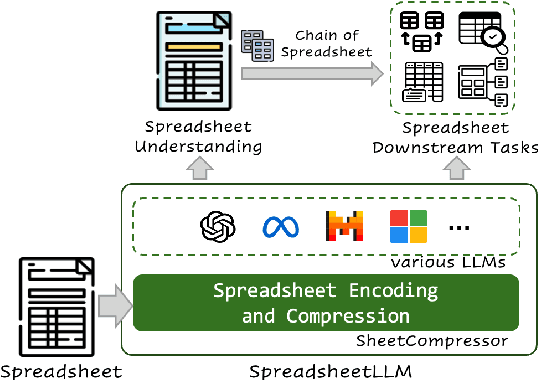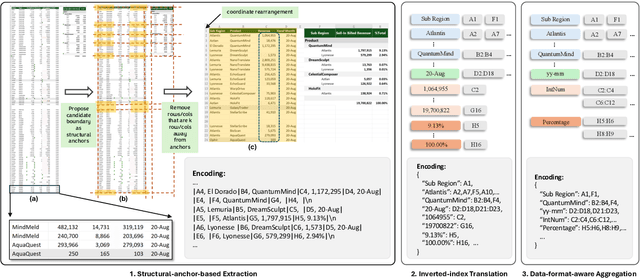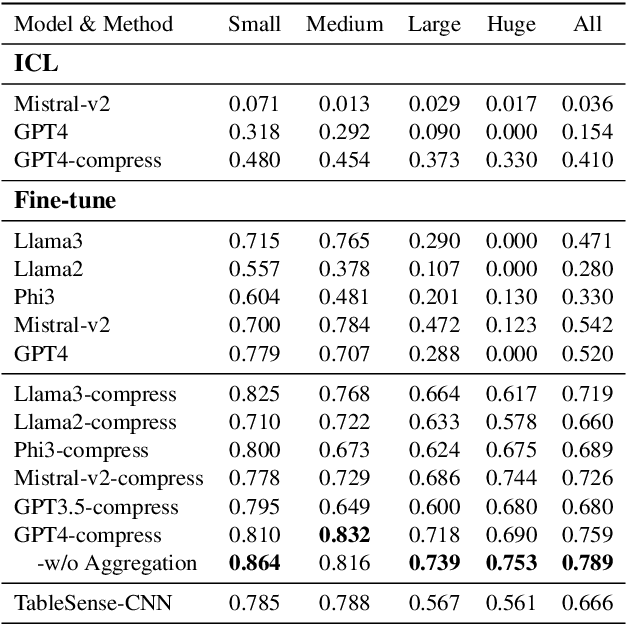Yeye He
Auto-Test: Learning Semantic-Domain Constraints for Unsupervised Error Detection in Tables
Apr 14, 2025Abstract:Data cleaning is a long-standing challenge in data management. While powerful logic and statistical algorithms have been developed to detect and repair data errors in tables, existing algorithms predominantly rely on domain-experts to first manually specify data-quality constraints specific to a given table, before data cleaning algorithms can be applied. In this work, we propose a new class of data-quality constraints that we call Semantic-Domain Constraints, which can be reliably inferred and automatically applied to any tables, without requiring domain-experts to manually specify on a per-table basis. We develop a principled framework to systematically learn such constraints from table corpora using large-scale statistical tests, which can further be distilled into a core set of constraints using our optimization framework, with provable quality guarantees. Extensive evaluations show that this new class of constraints can be used to both (1) directly detect errors on real tables in the wild, and (2) augment existing expert-driven data-cleaning techniques as a new class of complementary constraints. Our extensively labeled benchmark dataset with 2400 real data columns, as well as our code are available at https://github.com/qixuchen/AutoTest to facilitate future research.
TableLoRA: Low-rank Adaptation on Table Structure Understanding for Large Language Models
Mar 06, 2025Abstract:Tabular data are crucial in many fields and their understanding by large language models (LLMs) under high parameter efficiency paradigm is important. However, directly applying parameter-efficient fine-tuning (PEFT) techniques to tabular tasks presents significant challenges, particularly in terms of better table serialization and the representation of two-dimensional structured information within a one-dimensional sequence. To address this, we propose TableLoRA, a module designed to improve LLMs' understanding of table structure during PEFT. It incorporates special tokens for serializing tables with special token encoder and uses 2D LoRA to encode low-rank information on cell positions. Experiments on four tabular-related datasets demonstrate that TableLoRA consistently outperforms vanilla LoRA and surpasses various table encoding methods tested in control experiments. These findings reveal that TableLoRA, as a table-specific LoRA, enhances the ability of LLMs to process tabular data effectively, especially in low-parameter settings, demonstrating its potential as a robust solution for handling table-related tasks.
Table-LLM-Specialist: Language Model Specialists for Tables using Iterative Generator-Validator Fine-tuning
Oct 16, 2024



Abstract:In this work, we propose Table-LLM-Specialist, or Table-Specialist for short, as a new self-trained fine-tuning paradigm specifically designed for table tasks. Our insight is that for each table task, there often exist two dual versions of the same task, one generative and one classification in nature. Leveraging their duality, we propose a Generator-Validator paradigm, to iteratively generate-then-validate training data from language-models, to fine-tune stronger \sys models that can specialize in a given task, without requiring manually-labeled data. Our extensive evaluations suggest that our Table-Specialist has (1) \textit{strong performance} on diverse table tasks over vanilla language-models -- for example, Table-Specialist fine-tuned on GPT-3.5 not only outperforms vanilla GPT-3.5, but can often match or surpass GPT-4 level quality, (2) \textit{lower cost} to deploy, because when Table-Specialist fine-tuned on GPT-3.5 achieve GPT-4 level quality, it becomes possible to deploy smaller models with lower latency and inference cost, with comparable quality, and (3) \textit{better generalizability} when evaluated across multiple benchmarks, since \sys is fine-tuned on a broad range of training data systematically generated from diverse real tables. Our code and data will be available at https://github.com/microsoft/Table-LLM-Specialist.
SpreadsheetLLM: Encoding Spreadsheets for Large Language Models
Jul 12, 2024



Abstract:Spreadsheets, with their extensive two-dimensional grids, various layouts, and diverse formatting options, present notable challenges for large language models (LLMs). In response, we introduce SpreadsheetLLM, pioneering an efficient encoding method designed to unleash and optimize LLMs' powerful understanding and reasoning capability on spreadsheets. Initially, we propose a vanilla serialization approach that incorporates cell addresses, values, and formats. However, this approach was limited by LLMs' token constraints, making it impractical for most applications. To tackle this challenge, we develop SheetCompressor, an innovative encoding framework that compresses spreadsheets effectively for LLMs. It comprises three modules: structural-anchor-based compression, inverse index translation, and data-format-aware aggregation. It significantly improves performance in spreadsheet table detection task, outperforming the vanilla approach by 25.6% in GPT4's in-context learning setting. Moreover, fine-tuned LLM with SheetCompressor has an average compression ratio of 25 times, but achieves a state-of-the-art 78.9% F1 score, surpassing the best existing models by 12.3%. Finally, we propose Chain of Spreadsheet for downstream tasks of spreadsheet understanding and validate in a new and demanding spreadsheet QA task. We methodically leverage the inherent layout and structure of spreadsheets, demonstrating that SpreadsheetLLM is highly effective across a variety of spreadsheet tasks.
Vision Language Models for Spreadsheet Understanding: Challenges and Opportunities
May 25, 2024



Abstract:This paper explores capabilities of Vision Language Models on spreadsheet comprehension. We propose three self-supervised challenges with corresponding evaluation metrics to comprehensively evaluate VLMs on Optical Character Recognition (OCR), spatial perception, and visual format recognition. Additionally, we utilize the spreadsheet table detection task to assess the overall performance of VLMs by integrating these challenges. To probe VLMs more finely, we propose three spreadsheet-to-image settings: column width adjustment, style change, and address augmentation. We propose variants of prompts to address the above tasks in different settings. Notably, to leverage the strengths of VLMs in understanding text rather than two-dimensional positioning, we propose to decode cell values on the four boundaries of the table in spreadsheet boundary detection. Our findings reveal that VLMs demonstrate promising OCR capabilities but produce unsatisfactory results due to cell omission and misalignment, and they notably exhibit insufficient spatial and format recognition skills, motivating future work to enhance VLMs' spreadsheet data comprehension capabilities using our methods to generate extensive spreadsheet-image pairs in various settings.
Auto-Formula: Recommend Formulas in Spreadsheets using Contrastive Learning for Table Representations
Apr 19, 2024Abstract:Spreadsheets are widely recognized as the most popular end-user programming tools, which blend the power of formula-based computation, with an intuitive table-based interface. Today, spreadsheets are used by billions of users to manipulate tables, most of whom are neither database experts nor professional programmers. Despite the success of spreadsheets, authoring complex formulas remains challenging, as non-technical users need to look up and understand non-trivial formula syntax. To address this pain point, we leverage the observation that there is often an abundance of similar-looking spreadsheets in the same organization, which not only have similar data, but also share similar computation logic encoded as formulas. We develop an Auto-Formula system that can accurately predict formulas that users want to author in a target spreadsheet cell, by learning and adapting formulas that already exist in similar spreadsheets, using contrastive-learning techniques inspired by "similar-face recognition" from compute vision. Extensive evaluations on over 2K test formulas extracted from real enterprise spreadsheets show the effectiveness of Auto-Formula over alternatives. Our benchmark data is available at https://github.com/microsoft/Auto-Formula to facilitate future research.
Table-GPT: Table-tuned GPT for Diverse Table Tasks
Oct 13, 2023Abstract:Language models, such as GPT-3.5 and ChatGPT, demonstrate remarkable abilities to follow diverse human instructions and perform a wide range of tasks. However, when probing language models using a range of basic table-understanding tasks, we observe that today's language models are still sub-optimal in many table-related tasks, likely because they are pre-trained predominantly on \emph{one-dimensional} natural-language texts, whereas relational tables are \emph{two-dimensional} objects. In this work, we propose a new "\emph{table-tuning}" paradigm, where we continue to train/fine-tune language models like GPT-3.5 and ChatGPT, using diverse table-tasks synthesized from real tables as training data, with the goal of enhancing language models' ability to understand tables and perform table tasks. We show that our resulting Table-GPT models demonstrate (1) better \emph{table-understanding} capabilities, by consistently outperforming the vanilla GPT-3.5 and ChatGPT, on a wide-range of table tasks, including holdout unseen tasks, and (2) strong \emph{generalizability}, in its ability to respond to diverse human instructions to perform new table-tasks, in a manner similar to GPT-3.5 and ChatGPT.
Auto-Tables: Synthesizing Multi-Step Transformations to Relationalize Tables without Using Examples
Aug 09, 2023Abstract:Relational tables, where each row corresponds to an entity and each column corresponds to an attribute, have been the standard for tables in relational databases. However, such a standard cannot be taken for granted when dealing with tables "in the wild". Our survey of real spreadsheet-tables and web-tables shows that over 30% of such tables do not conform to the relational standard, for which complex table-restructuring transformations are needed before these tables can be queried easily using SQL-based analytics tools. Unfortunately, the required transformations are non-trivial to program, which has become a substantial pain point for technical and non-technical users alike, as evidenced by large numbers of forum questions in places like StackOverflow and Excel/Power-BI/Tableau forums. We develop an Auto-Tables system that can automatically synthesize pipelines with multi-step transformations (in Python or other languages), to transform non-relational tables into standard relational forms for downstream analytics, obviating the need for users to manually program transformations. We compile an extensive benchmark for this new task, by collecting 244 real test cases from user spreadsheets and online forums. Our evaluation suggests that Auto-Tables can successfully synthesize transformations for over 70% of test cases at interactive speeds, without requiring any input from users, making this an effective tool for both technical and non-technical users to prepare data for analytics.
Auto-Validate by-History: Auto-Program Data Quality Constraints to Validate Recurring Data Pipelines
Jun 04, 2023



Abstract:Data pipelines are widely employed in modern enterprises to power a variety of Machine-Learning (ML) and Business-Intelligence (BI) applications. Crucially, these pipelines are \emph{recurring} (e.g., daily or hourly) in production settings to keep data updated so that ML models can be re-trained regularly, and BI dashboards refreshed frequently. However, data quality (DQ) issues can often creep into recurring pipelines because of upstream schema and data drift over time. As modern enterprises operate thousands of recurring pipelines, today data engineers have to spend substantial efforts to \emph{manually} monitor and resolve DQ issues, as part of their DataOps and MLOps practices. Given the high human cost of managing large-scale pipeline operations, it is imperative that we can \emph{automate} as much as possible. In this work, we propose Auto-Validate-by-History (AVH) that can automatically detect DQ issues in recurring pipelines, leveraging rich statistics from historical executions. We formalize this as an optimization problem, and develop constant-factor approximation algorithms with provable precision guarantees. Extensive evaluations using 2000 production data pipelines at Microsoft demonstrate the effectiveness and efficiency of AVH.
Ground Truth Inference for Weakly Supervised Entity Matching
Nov 13, 2022



Abstract:Entity matching (EM) refers to the problem of identifying pairs of data records in one or more relational tables that refer to the same entity in the real world. Supervised machine learning (ML) models currently achieve state-of-the-art matching performance; however, they require many labeled examples, which are often expensive or infeasible to obtain. This has inspired us to approach data labeling for EM using weak supervision. In particular, we use the labeling function abstraction popularized by Snorkel, where each labeling function (LF) is a user-provided program that can generate many noisy match/non-match labels quickly and cheaply. Given a set of user-written LFs, the quality of data labeling depends on a labeling model to accurately infer the ground-truth labels. In this work, we first propose a simple but powerful labeling model for general weak supervision tasks. Then, we tailor the labeling model specifically to the task of entity matching by considering the EM-specific transitivity property. The general form of our labeling model is simple while substantially outperforming the best existing method across ten general weak supervision datasets. To tailor the labeling model for EM, we formulate an approach to ensure that the final predictions of the labeling model satisfy the transitivity property required in EM, utilizing an exact solution where possible and an ML-based approximation in remaining cases. On two single-table and nine two-table real-world EM datasets, we show that our labeling model results in a 9% higher F1 score on average than the best existing method. We also show that a deep learning EM end model (DeepMatcher) trained on labels generated from our weak supervision approach is comparable to an end model trained using tens of thousands of ground-truth labels, demonstrating that our approach can significantly reduce the labeling efforts required in EM.
 Add to Chrome
Add to Chrome Add to Firefox
Add to Firefox Add to Edge
Add to Edge